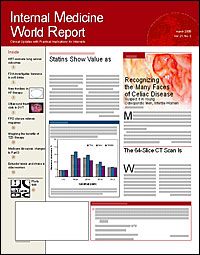Publication
Article
TZD Therapy: Benefits After Coronary Stenting and Beyond By Laura Brasseur
Author(s):
Recent evidence has demonstrated that thiazolidinedione (TZD) treatment reduces the risk of restenosis after coronary stent placement. A new study has apparently pinpointed the reason: TZD agents decrease the production of leptin, which in turn improves insulin resistance and endothelial function (Diabetes Care. 2006;29:101-106).
This prospective trial included 54 patients with type 2 diabetes who had been referred for coronary stenting. They were randomly assigned to either treatment with the TZD pioglitazone (Actos) or to a control group.
Laboratory and angiographic evaluations were performed at baseline and at 6 months after coronary stenting. At follow-up, levels of in?sulin, homeostasis model assessment of insulin re?sistance, endothelial nitric oxide synthase, and leptin were significantly lower in the pioglitazone group. The TZD group also had significantly less late luminal loss and a 7-fold reduction in the rate of in-stent restenosis.
"This study demonstrated that pioglitazone significantly reduced restenosis 6 months after coronary stenting in the type 2 diabetic patients," Kazuaki Nishiom, MD, PhD, Showa University School of Medicine, Tokyo, Japan, and coauthors wrote. "These effects were dependent on improving endothelial function and the decreased leptin by the treatment with pioglitazone."
Leptin is a hormone that is involved in fat metabolism and insulin resistance. It has been identified as an independent risk factor for coronary heart disease, and it promotes vascular remodeling and the proliferation of neointimal tissue.
Insulin appears to regulate the production of leptin, and leptin is strongly associated with insulin concentrations. As a result, continuous insulin resistance increases the chances of restenosis after coronary stenting.
"Our data suggested that the endothelium with insulin resistance is hyperactivated by hyperleptinemia, that it causes excess proliferation of the impaired endothelium after coronary stenting, and that the treatment with pioglitazone reduced leptin and improved endothelial function," the investigators concluded.
Writing a commentary in the same issue of Diabetes Care (pages 154-157), David M. Kendall, MD, director, International Diabetes Center, Minnea?polis, listed other notable advantages that TZDs (or "glitazones") have over other antidiabetes treatments:
? TZDs improve and maintain intensive glucose control by heightening insulin sensitivity and enhancing beta-cell secretory function
? TZDs play a role in the prevention of diabetes
? TZDs improve cardiovascular disease (CVD) risk factors and lower the incidence of CVD events (Table).
While noting that all the standard oral agents used in patients with type 2 diabetes have fairly equivalent glucose-lowering effects, "the glitazones uniquely target insulin resistance and thereby achieve stable blood glucose control over periods of >=2 years," Dr Kendall writes.
He adds that such sustained improvement is largely due to enhanced beta-cell secretory function over time: "The ability of glitazones to improve insulin secretion is unique among current diabetes therapies."
Both metformin (Glucophage) and the glitazones have demonstrated an ability to prevent progression to type 2 diabetes in at-risk individuals. Metformin has been shown to reduce risk by about 30% (ie, less than with intensive lifestyle changes), but some data suggest it may merely be masking diabetes. "In contrast?glitazones have been shown to reduce the risk of diabetes by >50%, an effect similar in magnitude to that observed with intensive lifestyle changes," according to Dr Kendall. On the other hand, some data suggest that only active treatment with TZD agents can prevent diabetes.
Despite their many advantages, some physicians are still reluctant to use glitazones, feeling they are an unproven therapy backed by limited experience, their cost is too high, or their long-term safety is uncertain.
Dr Kendall points out that physicians have been prescribing these agents for 7 years, which amounts to >10 million patient-years of experience. Glitazones are usually well-tolerated, although a small minority of patients experience fluid retention, weight gain, or rarely, heart failure. He argues, however, that these "equivocal safety concerns" pale in the face of the myriad benefits TZD ?therapy offer.
"The time has come to accept insulin-sensitizing therapy as a standard of treatment for patients with type 2 diabetes," Dr Kendall argues. "Glitazones must be considered early in the course of management for type 2 diabetes, particularly in those at significant risk for cardio?vascular complications.






